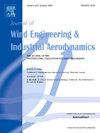立面和屋顶绿化对带侧壁开孔的孤立立方体建筑表面压力分布的影响
IF 4.9
2区 工程技术
Q1 ENGINEERING, CIVIL
Journal of Wind Engineering and Industrial Aerodynamics
Pub Date : 2025-07-23
DOI:10.1016/j.jweia.2025.106174
引用次数: 0
摘要
绿化被认为是城市发展的可持续和环境友好型政策,但尽管迄今取得了进展,建筑嵌入式绿化的空气动力学影响尚未确定。绿化可能会对风荷载、自然通风和空气交换产生各种影响,这些影响都与建筑物外表面的压力分布有关。在本研究中,风洞调查研究了建筑绿化对模型建筑外表面压力分布的定性和定量影响。绿化被认为完全覆盖了外部迎风立面和不同透水性和厚度的屋顶。侧壁上的开口允许室内外空气交换。绿化的位置和厚度被发现是整体压力分布的决定性参数,但也要注意开口附近的波动压力,这有望成为这种配置中空气交换的驱动机制。屋顶绿化的效果主要局限于屋顶和尾流,但对于迎风立面绿化,与裸露的建筑相比,在开口附近观察到的平均和波动压力差高达35%。主要的影响是对较低频率的压力波动的阻尼,它对迎风面绿化的厚度而不是材料特性有更强的依赖性。本文章由计算机程序翻译,如有差异,请以英文原文为准。
Effects of façade and rooftop greening on the surface pressure distribution of an isolated cubic building with side wall apertures
Greening is considered a sustainable and environmentally friendly policy for urban development but despite the progress made so far, the aerodynamic implications of building embedded greening have yet to be determined. Greening may have a variety of implications on wind loads, natural ventilation and air exchange, all related to the pressure distribution on buildings’ external surfaces. In the present study, a wind tunnel investigation deals with the qualitative and quantitative effects of building greening on the external surface pressure distribution of a model building. Greening was considered to fully cover the external windward façade and the roof under various permeabilities and thicknesses. Openings on the side walls allow for indoor–outdoor air exchange. The position and the thickness of greening were found to be decisive parameters for the overall pressure distribution but attention was also directed towards the fluctuating pressures near the openings, which are expected to be the driving mechanism for air exchange in this configuration. Effects of rooftop greening were confined mainly to the roof and the wake but for windward façade greening, mean and fluctuating pressure differences of up to 35%, compared to the bare building, were observed in the vicinity of the openings. The major effect was a damping of the lower frequencies of pressure fluctuations and it had a stronger dependence on the thickness rather than the material properties of the windward façade greening.
求助全文
通过发布文献求助,成功后即可免费获取论文全文。
去求助
来源期刊
CiteScore
8.90
自引率
22.90%
发文量
306
审稿时长
4.4 months
期刊介绍:
The objective of the journal is to provide a means for the publication and interchange of information, on an international basis, on all those aspects of wind engineering that are included in the activities of the International Association for Wind Engineering http://www.iawe.org/. These are: social and economic impact of wind effects; wind characteristics and structure, local wind environments, wind loads and structural response, diffusion, pollutant dispersion and matter transport, wind effects on building heat loss and ventilation, wind effects on transport systems, aerodynamic aspects of wind energy generation, and codification of wind effects.
Papers on these subjects describing full-scale measurements, wind-tunnel simulation studies, computational or theoretical methods are published, as well as papers dealing with the development of techniques and apparatus for wind engineering experiments.

 求助内容:
求助内容: 应助结果提醒方式:
应助结果提醒方式:


